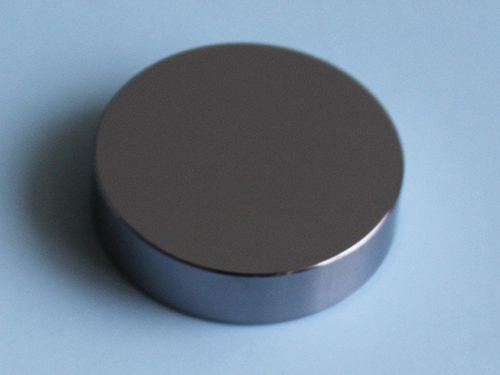Ge
 Ge shows good transmission in 2-15μm range. It has minimal chromatic aberration due to its high refractive index and low dispersion. A lens made of Ge brings minimal chromatic aberration and is very popular for IR systems operating in the 3-5 or 8-12μm spectrum. Ge is also a good electromagnetic interference (EMI) shielding material. EMI grade Ge windows with low resistance of 4-6 ohms are able to shield against electromagnetic interference within millimeter and centimeter ranges, allowing the IR system to show measurably better performance.
Ge shows good transmission in 2-15μm range. It has minimal chromatic aberration due to its high refractive index and low dispersion. A lens made of Ge brings minimal chromatic aberration and is very popular for IR systems operating in the 3-5 or 8-12μm spectrum. Ge is also a good electromagnetic interference (EMI) shielding material. EMI grade Ge windows with low resistance of 4-6 ohms are able to shield against electromagnetic interference within millimeter and centimeter ranges, allowing the IR system to show measurably better performance.
Ge blocks UV and visible light, as well as IR up to 2μm. Its density 5.323 gram/mm³ is highest of the IR transmitting materials, these properties limit its use to visible or NIR light combination and weight restricted systems.
Optical Properties ( @ 10.6μm )
Bulk Absorption Coefficient < 0.03/cm
Refractive Index 4.0028
Temperature change of Refractive Index 390 ×10-6 /?
Thermal Properties
Thermal Conductivity at 20°C 0.59 W /cm/°C
Specific Heat 0.31 J /g/°C
Linear Expansion Coefficient @ 20°C 5.7 ×10-6/°C
Mechanical Properties
Youngs Modulus 102.7 GPa
Rupture Modulus 93 Mpa
Knoop Hardness 780 Kg/ mm²
Poisson Ratio 0.28
Density 5.323 g/cm³
Typical Specifications:
<111> Oriented within 2°deviation
Conductivity type: n
Specific resistance: 3-40 Ohm·cm
Clear Aperture 90%
Dimension Tolerance +0/-0.2mm
Thickness Tolerance ±0.2mm
Surface quality: 60/40 S/D after coating, 40/20 S/D before coating
Surface figure: 1/4 to 2 waves @ 632.8nm
Parallelism < 3 arc minutes
BBAR Coating R avg < 2% per surface @ 3-5μm
R avg < 2% per surface @ 8-12μm
 Ge shows good transmission in 2-15μm range. It has minimal chromatic aberration due to its high refractive index and low dispersion. A lens made of Ge brings minimal chromatic aberration and is very popular for IR systems operating in the 3-5 or 8-12μm spectrum. Ge is also a good electromagnetic interference (EMI) shielding material. EMI grade Ge windows with low resistance of 4-6 ohms are able to shield against electromagnetic interference within millimeter and centimeter ranges, allowing the IR system to show measurably better performance.
Ge shows good transmission in 2-15μm range. It has minimal chromatic aberration due to its high refractive index and low dispersion. A lens made of Ge brings minimal chromatic aberration and is very popular for IR systems operating in the 3-5 or 8-12μm spectrum. Ge is also a good electromagnetic interference (EMI) shielding material. EMI grade Ge windows with low resistance of 4-6 ohms are able to shield against electromagnetic interference within millimeter and centimeter ranges, allowing the IR system to show measurably better performance.

